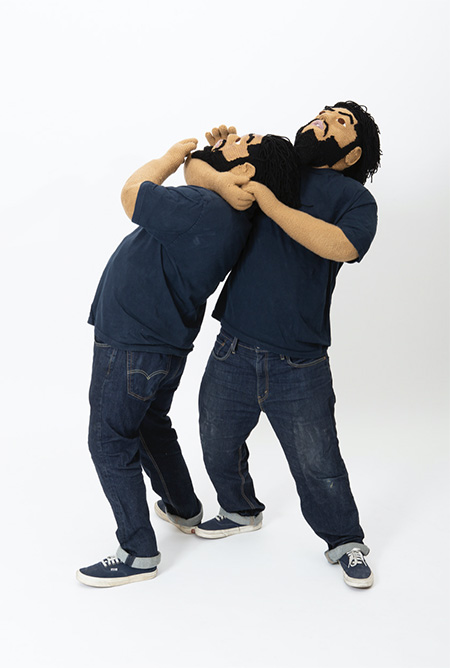
Continuing through January 12, 2020
The centerpiece of “thread.” is the life-size sculpture, “Heartbreaker” by Luis Flores. The 60-inch tall depiction of a young man in fighting stance, clad in jeans, t-shirt and sneakers, is so realistic, we might think we’ve stumbled on an aggressive interloper within the museum. While it parodies an aggressive young man, the work is surprisingly constructed entirely of yarn. “Venus,” also made from yarn, parodies the archetypal female. Possessing the body parts of a classic Venus, the piece is so squished together that it looks more like an abstract sculpture than an elegant female figure. The exhibition is full of cleverly wrought works such as these, all created using fiber craft techniques, along with gluing and pasting. In addition to the expected yarn and other fibers, materials include found objects such as toothbrushes, pipe cleaners and old computer keys.
Hannah Epstein’s “Bad Mascot,” “Catemine,” “Dragon Boy” and “Soft Teeth” are furry, colorful, growly pieces, made from wool, polyester, burlap and acrylic paint. All conjure up the amusing yet ferocious drawings of Maurice Sendak in his “Wild Things” book. Nearby are Epstein’s seven “Interstellar Space Crew” pieces, made from colorful pipe cleaners into wildly expressive outer space creatures. They are as playful as it sounds. Another intriguing work is a black tapestry titled “Framed in Colonial Lenses,” created by Moffat Takadiwa out of found computer keys. This 98-inch wide abstract creation, is shaped like a canopy, with its dark color and omnipresent shape suggesting oppression under colonialism. Takadiwa, who is from Zimbabwe, also contributed to this show “Scarlet Gown” (2018), a bluish evening dress, assembled from numerous toothbrushes. While the shimmering gown appears to be elegant, its structure and scratchy surface render it as unwearable as colonialism was to maintaining a free people.
Using everyday materials, the artists of “thread.” evoke a full range of human emotions, from love and familial harmony, to anger and sorrow. Miyoshi Barosh’s “Rainbow of Tears” (2015), in which found afghans and Poly-fil form a tall sculptural presence, reads as a colorful cascading of tears. It’s a larger-than-life vision of deeply felt emotions.
